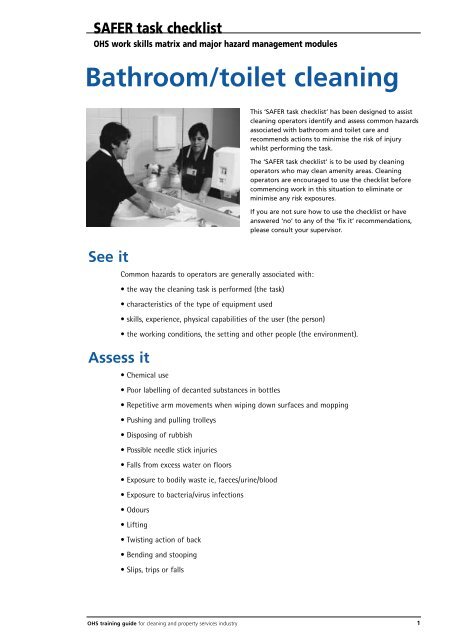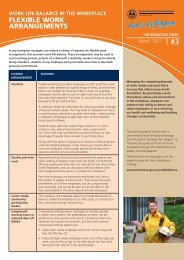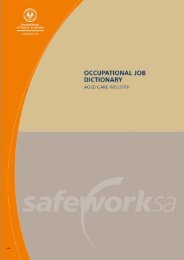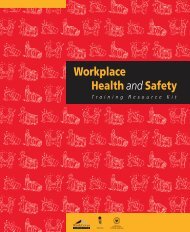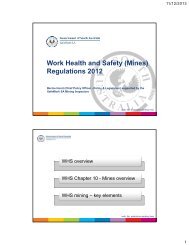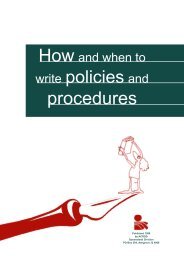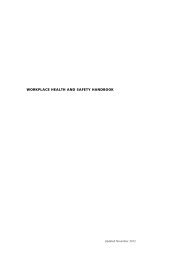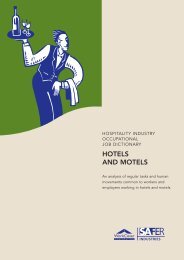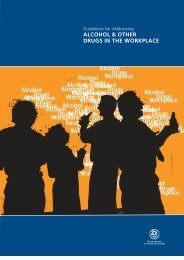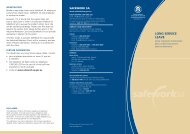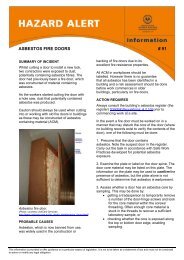OHS Training Guide: Cleaning property services ... - SafeWork SA
OHS Training Guide: Cleaning property services ... - SafeWork SA
OHS Training Guide: Cleaning property services ... - SafeWork SA
You also want an ePaper? Increase the reach of your titles
YUMPU automatically turns print PDFs into web optimized ePapers that Google loves.
<strong>SA</strong>FER task checklist<br />
<strong>OHS</strong> work skills matrix and major hazard management modules<br />
Bathroom/toilet cleaning<br />
See it Common hazards to operators are generally associated with:<br />
Assess it<br />
• the way the cleaning task is performed (the task)<br />
• characteristics of the type of equipment used<br />
• skills, experience, physical capabilities of the user (the person)<br />
• the working conditions, the setting and other people (the environment).<br />
• Chemical use<br />
• Poor labelling of decanted substances in bottles<br />
• Repetitive arm movements when wiping down surfaces and mopping<br />
• Pushing and pulling trolleys<br />
• Disposing of rubbish<br />
• Possible needle stick injuries<br />
• Falls from excess water on floors<br />
• Exposure to bodily waste ie, faeces/urine/blood<br />
• Exposure to bacteria/virus infections<br />
• Odours<br />
• Lifting<br />
• Twisting action of back<br />
• Bending and stooping<br />
• Slips, trips or falls<br />
<strong>OHS</strong> training guide for cleaning and <strong>property</strong> <strong>services</strong> industry<br />
This ‘<strong>SA</strong>FER task checklist’ has been designed to assist<br />
cleaning operators identify and assess common hazards<br />
associated with bathroom and toilet care and<br />
recommends actions to minimise the risk of injury<br />
whilst performing the task.<br />
The ‘<strong>SA</strong>FER task checklist’ is to be used by cleaning<br />
operators who may clean amenity areas. <strong>Cleaning</strong><br />
operators are encouraged to use the checklist before<br />
commencing work in this situation to eliminate or<br />
minimise any risk exposures.<br />
If you are not sure how to use the checklist or have<br />
answered ‘no’ to any of the ‘fix it’ recommendations,<br />
please consult your supervisor.<br />
1
Bathroom/toilet cleaning<br />
<strong>OHS</strong> work skills matrix and major hazard management modules<br />
Fix it<br />
1. Select the correct commercially prepared chemicals for the cleaning<br />
task ie, disinfectants and cleaning solutions.<br />
2. Where chemicals are to be prepared use the correct amounts as<br />
directed on labels/procedures.<br />
3. Select the appropriate equipment for the task.<br />
4. Wear personal protective equipment when cleaning urinals, toilet<br />
bowls, hand basins and mirrors ie, gloves at all times and non-slip<br />
rubber soled shoes.<br />
5. When working at floor level, kneel or squat down.<br />
6. Avoid reaching into semi-hidden areas.<br />
7. When working at bench height, get close to the area you’re<br />
cleaning. Start at the nearest point then work outwards, using even<br />
strokes.<br />
8. Empty bins by removing liners only or directly pouring contents<br />
into the collection container.<br />
9. When mopping, only half fill buckets to reduce weight.<br />
10. Remove any excess water.<br />
11. Place warning signs ‘Danger wet floors’ to warn others.<br />
Evaluate it<br />
The control measures should be evaluated both during and after<br />
implementation. Possible questions are:<br />
• Has the ‘fix it’ recommendations eliminated or reduced the risks<br />
associated with bathroom and toilet cleaning?<br />
• Can an alternative chemical substance be used?<br />
• Has the ‘fix it’ recommendations created a new hazard?<br />
• Is there a need for information, instruction and training for<br />
people at the time of implementing the control measure?<br />
Review it<br />
A review of the entire hazard management process should be<br />
performed at regular intervals during the term of the contract.<br />
• This can be part of a regular inspection, when the work<br />
environment changes or when work practices change,<br />
to ensure that no new hazards have been introduced.<br />
• It could also be part of a system audit.<br />
This review process completes the continuous improvement cycle.<br />
Review it<br />
Evaluate it<br />
Recommend<br />
2 <strong>OHS</strong> training guide for cleaning and <strong>property</strong> <strong>services</strong> industry<br />
Actioned<br />
Yes No<br />
✓ <br />
✓<br />
✓<br />
✓<br />
<br />
✓<br />
✓<br />
✓<br />
<br />
<br />
<br />
✓<br />
✓<br />
✓<br />
✓<br />
<br />
<br />
<br />
✓<br />
✓<br />
✓<br />
✓<br />
<br />
<br />
<br />
See it<br />
<br />
<br />
<br />
<br />
<br />
<br />
<br />
<br />
<br />
<br />
<br />
<br />
<br />
<br />
Fix it<br />
Assess it
<strong>SA</strong>FER task checklist<br />
<strong>OHS</strong> work skills matrix and major hazard management modules<br />
Buffing floors<br />
See it Common hazards to operators are generally associated with:<br />
Assess it<br />
• the way the cleaning task is performed (the task)<br />
• characteristics of the type of plant and equipment<br />
• skills, experience, physical capabilities of the user (the person)<br />
• the working conditions, the setting and other people (the environment).<br />
• Poor preparation of the area<br />
• Possibility of electric shock<br />
• Size of the floor area<br />
• Available power source<br />
• Poor maintenance of equipment<br />
• Manual handling difficulties<br />
• Vibration<br />
• Incorrect pad type fitted for floor surface and conditions<br />
• Poor preparation of buffing solution<br />
• Lack of training or experience in the use of equipment<br />
• Number and type of obstacles<br />
• Flexible cords may present tripping hazards to the operator and others<br />
• Warning signs not used<br />
• Personal protective equipment not used<br />
• Slips, trips and falls<br />
<strong>OHS</strong> training guide for cleaning and <strong>property</strong> <strong>services</strong> industry<br />
This ‘<strong>SA</strong>FER task checklist’ has been designed to assist<br />
cleaning operators identify and assess common hazards<br />
associated with buffing floors and recommends actions<br />
to minimise the risk of injury whilst performing the task.<br />
Buffing is a task that presents a range of common hazards<br />
to operators. The ‘<strong>SA</strong>FER task checklist is to be used by<br />
cleaning operators who perform buffing tasks as part of<br />
their duties. <strong>Cleaning</strong> operators are encouraged to use<br />
the checklist before commencing the buffing task to<br />
eliminate or minimise any risk exposures.<br />
If you are not sure how to use the checklist or have<br />
answered ‘no’ to any of the ‘fix it’ recommendations,<br />
please consult your supervisor.<br />
3
Buffing floors<br />
<strong>OHS</strong> work skills matrix and major hazard management modules<br />
Fix it<br />
1. Select a well maintained polisher.<br />
Recommend<br />
✓<br />
2. Select and fit an appropriate pad or brush to suit the floor surface<br />
and condition.<br />
✓<br />
3. Ensure that the flexible cords have been inspected, tested and tagged<br />
by a competent person.<br />
✓<br />
4. Visually inspect the cord and plug for damage. If damaged, replace unit<br />
and report it to your supervisor. Remove from service.<br />
5. Ensure that power outlets are RCD protected. If not, use portable RCD units.<br />
6. Place "Danger wet floor" signs.<br />
7. Prepare the work area ie, sweep and damp mop the floor area.<br />
8. Use the recommended amount of detergent in water.<br />
✓<br />
✓<br />
✓<br />
✓<br />
✓<br />
9. Prepare buffing solution in spray bottle wearing the recommended personal<br />
protective equipment.<br />
✓<br />
10. Spray the buffing solution approximately half a metre from the floor,<br />
using a fine mist ahead of the buffer.<br />
11. Machine burnish over the sprayed area.<br />
12. Buff the edges first.<br />
13. Buff the floor using a sweeping action.<br />
14. Avoid reaching too far whilst burnishing.<br />
15. Avoid burnishing for long periods of time.<br />
16. Sweep floors after burnishing if required.<br />
17. Wear appropriate footwear ie, rubber soled, non–slip shoes.<br />
18. Wash and clean equipment thoroughly, remove pad or brush before storage.<br />
✓<br />
✓<br />
Evaluate it<br />
The control measures should be evaluated both during and after<br />
implementation. Possible questions are:<br />
• Has the ‘fix it’ recommendations eliminated or reduced the risks<br />
associated with the buffing?<br />
• Has the ‘fix it’ recommendations created a new hazard?<br />
• Is there a need for information, instruction and training for people<br />
at the time of implementing the control measure?<br />
Review it<br />
A review of the entire hazard management process should<br />
be performed at regular intervals during the term of the contract.<br />
• This can be part of a regular inspection, when the work<br />
environment changes or when work practices change,<br />
to ensure that no new hazards have been introduced.<br />
• It could also be part of a system audit.<br />
This review process completes the continuous improvement cycle.<br />
Review it<br />
Evaluate it<br />
4 <strong>OHS</strong> training guide for cleaning and <strong>property</strong> <strong>services</strong> industry<br />
<br />
<br />
<br />
<br />
<br />
<br />
<br />
<br />
<br />
Actioned<br />
Yes No<br />
<br />
✓<br />
✓<br />
✓<br />
✓<br />
<br />
See it<br />
<br />
<br />
<br />
<br />
<br />
<br />
<br />
<br />
<br />
<br />
<br />
<br />
<br />
<br />
<br />
<br />
<br />
<br />
<br />
<br />
Fix it<br />
Assess it
<strong>SA</strong>FER task checklist<br />
<strong>OHS</strong> work skills matrix and major hazard management modules<br />
Carpet cleaning<br />
See it Common hazards to operators are generally associated with:<br />
Assess it<br />
• the way the cleaning task is performed (the task)<br />
• characteristics of the type of equipment used<br />
• skills, experience, physical capabilities of the user (the person)<br />
• the working conditions, the setting and other people (the environment).<br />
• Use of chemicals ie, decanting/mixing/spraying/spills<br />
• Electrical<br />
• Damage to floors/paint work/furniture<br />
• Manual handling involving shifting furniture<br />
• Use of equipment ie, vacuum cleaner (upright/backpack),<br />
dry cleaning buffing machine and carpet rake<br />
• No material safety data sheets supplied with substance<br />
• Procedures not followed<br />
• Personal protective equipment not worn<br />
<strong>OHS</strong> training guide for cleaning and <strong>property</strong> <strong>services</strong> industry<br />
This ‘<strong>SA</strong>FER task checklist’ has been designed to assist<br />
cleaning operators identify and assess common hazards<br />
associated with carpet cleaning and recommends actions<br />
to minimise the risk of injury whilst performing the task.<br />
The ‘<strong>SA</strong>FER task checklist’ is to be used by cleaning<br />
operators who are required to clean carpets, whether<br />
it be dry, shampoo or steam on a regular basis.<br />
<strong>Cleaning</strong> operators are encouraged to use the checklist<br />
before commencing work to eliminate or minimise<br />
any risk exposures.<br />
If you are not sure how to use the checklist or have<br />
answered ‘no’ to any of the ‘fix it’ recommendations,<br />
please consult your supervisor.<br />
5
Carpet cleaning<br />
<strong>OHS</strong> work skills matrix and major hazard management modules<br />
Fix it<br />
1. Select a well maintained dry cleaning buffing machine.<br />
2. Select and fit an appropriate pad.<br />
Recommend<br />
✓<br />
3. Ensure that the flexible cords have been inspected, tested and tagged<br />
by a competent person.<br />
✓<br />
4. Visually inspect the cord and plug for damage. If damaged replace unit<br />
and report it to your supervisor. Remove from service.<br />
5. Ensure that power outlets are RCD protected. If not, use portable RCD units.<br />
✓<br />
✓<br />
6. Check the safety requirements on material safety data sheets or labels<br />
of chemicals used and follow manufacturer’s instructions.<br />
7. Wear appropriate personal protective equipment ie, gloves.<br />
8. Inspect the carpets and report faulty joints, delaminating holes and stains.<br />
✓<br />
✓<br />
✓<br />
9. Remove light furniture and obtain assistance where heavier items<br />
require shifting.<br />
10. Place plastic squares under legs of remaining furniture.<br />
✓<br />
✓<br />
11. Vacuum the area with suitable vacuum cleaner for the job<br />
ie, backpack preferred.<br />
12. Wear gloves when spot cleaning.<br />
13. Avoid spraying dry cleaning fluid on paintwork and furniture.<br />
14. Buff carpet in a circular motion.<br />
15. Ventilate rooms if necessary.<br />
✓<br />
✓<br />
✓<br />
✓<br />
✓<br />
Evaluate it<br />
The control measures should be evaluated both during and after<br />
implementation. Possible questions are:<br />
• Has the ‘fix it’ recommendations eliminated or reduced the risks<br />
associated with chemical use?<br />
• Can an alternative chemical substance be used?<br />
• Has the ‘fix it’ recommendations created a new hazard?<br />
• Is there a need for information, instruction and training for people<br />
at the time of implementing the control measure?<br />
Review it<br />
A review of the entire hazard management process should<br />
be performed at regular intervals during the term of the contract.<br />
• This can be part of a regular inspection, when the work<br />
environment changes or when work practices change,<br />
to ensure that no new hazards have been introduced.<br />
• It could also be part of a system audit.<br />
This review process completes the continuous improvement cycle.<br />
Review it<br />
Evaluate it<br />
6 <strong>OHS</strong> training guide for cleaning and <strong>property</strong> <strong>services</strong> industry<br />
Actioned<br />
Yes No<br />
<br />
<br />
✓<br />
✓<br />
✓<br />
✓<br />
<br />
See it<br />
<br />
<br />
<br />
<br />
<br />
<br />
<br />
<br />
<br />
<br />
<br />
<br />
<br />
<br />
<br />
<br />
<br />
Fix it<br />
Assess it
<strong>SA</strong>FER task checklist<br />
<strong>OHS</strong> work skills matrix and major hazard management modules<br />
Chemical use<br />
See it Common hazards to operators are generally associated with:<br />
Assess it<br />
• the way the cleaning task is performed (the task)<br />
• characteristics of the type of equipment used<br />
• skills, experience, physical capabilities of the user (the person)<br />
• the working conditions, the setting and other people (the environment).<br />
• Hazardous chemical<br />
• Poor labelling<br />
• Decanting of chemical<br />
• Mixing of chemicals<br />
• Exposure to splashes<br />
• Exposure to fumes or mists<br />
• Exposure to powders or dusts<br />
• Poor storage practices of chemicals<br />
• Handling of bulk chemicals<br />
• Spills of chemicals<br />
• No material safety data sheets supplied with substance<br />
• Procedures not followed<br />
• Personal protective equipment not worn<br />
<strong>OHS</strong> training guide for cleaning and <strong>property</strong> <strong>services</strong> industry<br />
This ‘<strong>SA</strong>FER task checklist’ has been designed to assist<br />
cleaning operators identify and assess common hazards<br />
associated with chemical use and recommends actions<br />
to minimise the risk of injury whilst performing the task.<br />
The use of chemicals is a growing concern to operators.<br />
The ‘<strong>SA</strong>FER task checklist’ is to be used by cleaning<br />
operators who may use, handle, prepare, store and<br />
transport chemicals in the workplace. <strong>Cleaning</strong><br />
operators are encouraged to use the checklist before<br />
commencing work in this situation to eliminate or<br />
minimise any risk exposures.<br />
If you are not sure how to use the checklist or have<br />
answered ‘no’ to any of the ‘fix it’ recommendations,<br />
please consult your supervisor.<br />
7
Chemical use<br />
<strong>OHS</strong> work skills matrix and major hazard management modules<br />
Fix it<br />
1. Chemicals are labelled.<br />
2. Material safety data sheets are kept near the workplace.<br />
3. Select correct commercially prepared chemicals for the cleaning task.<br />
4. Where chemicals are to be prepared, use the correct amounts<br />
as directed on labels/procedures.<br />
5. Where chemicals are prepared, ensure the area is well ventilated.<br />
6. Wear personal protective equipment when handling or preparing chemical<br />
solutions ie, eye protection, gloves, mask (if required) and foot wear.<br />
7. When substances are decanted into smaller containers or spray bottles,<br />
label them correctly.<br />
8. First aid equipment and procedures are in place.<br />
9. Procedures are in place to contain large spills.<br />
10. Lock and store chemicals away.<br />
11. In bulk storage areas, containers with taps are not leaking<br />
or drip buckets are used to contain minor leaks.<br />
Evaluate it<br />
The control measures should be evaluated both during and after<br />
implementation. Possible questions are:<br />
• Has the ‘fix it’ recommendations eliminated or reduced the risks<br />
associated with chemical use?<br />
• Can an alternative chemical substance be used?<br />
• Has the ‘fix it’ recommendations created a new hazard?<br />
• Is there a need for information, instruction and training for people<br />
at the time of implementing the control measure?<br />
Review it<br />
A review of the entire hazard management process should<br />
be performed at regular intervals during the term of the contract.<br />
• This can be part of a regular inspection, when the work<br />
environment changes or when work practices change,<br />
to ensure that no new hazards have been introduced.<br />
• It could also be part of a system audit.<br />
This review process completes the continuous improvement cycle.<br />
Review it<br />
Evaluate it<br />
Recommend<br />
8 <strong>OHS</strong> training guide for cleaning and <strong>property</strong> <strong>services</strong> industry<br />
✓<br />
<br />
Actioned<br />
Yes No<br />
<br />
✓ <br />
<br />
<br />
<br />
<br />
✓<br />
✓<br />
✓<br />
✓<br />
✓<br />
✓<br />
✓<br />
✓<br />
✓<br />
✓<br />
✓<br />
✓<br />
✓<br />
<br />
See it<br />
Fix it<br />
<br />
<br />
<br />
<br />
<br />
<br />
<br />
<br />
<br />
<br />
<br />
<br />
Assess it
<strong>SA</strong>FER task checklist<br />
<strong>OHS</strong> work skills matrix and major hazard management modules<br />
Clinical/pharmaceutical waste<br />
See it Common hazards to operators are generally associated with:<br />
Assess it<br />
• the way the cleaning task is performed (the task)<br />
• characteristics of the type of equipment used<br />
• skills, experience, physical capabilities of the user (the person)<br />
• the working conditions, the setting and other people (the environment).<br />
• The handling, storage, transport and disposal of clinical waste<br />
• Skin penetrating objects ie, needles/sharps<br />
• Contact with infectious waste<br />
• Contact with blood products/animal carcasses<br />
• Soiled linen/dressings<br />
• Chemicals from laboratories<br />
• Discarded prescribed drugs<br />
• Waste or residue generated from producing and preparing drugs<br />
• Personal protective equipment not worn<br />
• Disposing of material in the wrong receptacle<br />
<strong>OHS</strong> training guide for cleaning and <strong>property</strong> <strong>services</strong> industry<br />
This ‘<strong>SA</strong>FER task checklist’ has been designed to assist<br />
cleaning operators identify and assess common hazards<br />
associated with handling and removing clinical waste<br />
and recommends actions to minimise the risk of injury<br />
whilst performing the task.<br />
The handling and removal of clinical/pharmaceutical<br />
waste is a growing concern to operators. The ‘<strong>SA</strong>FER<br />
task checklist’ is to be used by cleaning operators who<br />
may work in these type of environments. <strong>Cleaning</strong><br />
operators are encouraged to use the checklist before<br />
commencing work in this situation to eliminate or<br />
minimise any risk exposures.<br />
If you are not sure how to use the checklist or have<br />
answered ‘no’ to any of the ‘fix it’ recommendations,<br />
please consult your supervisor.<br />
9
Clinical/pharmaceutical waste<br />
<strong>OHS</strong> work skills matrix and major hazard management modules<br />
Fix it<br />
1. Avoid using and handling needles and sharp objects.<br />
2. Use rigid, puncture–proof containers for disposing of needles<br />
and sharps.<br />
3. Label containers correctly for specific types of wastes.<br />
4. Avoid handling linen or soiled laundry items.<br />
5. Use heavy gloves when emptying bins.<br />
6. Wear suitable protective clothing, such as overalls, gloves,<br />
face mask and footwear.<br />
7. A procedure is in place for staff when treating cuts or using<br />
dressings on wounds.<br />
8. Staff are immunised ie, for hepatitis, tetanus or Q fever.<br />
9. Maintain high standards of personal hygiene.<br />
10. Spill absorption material is available for use in liquid spills.<br />
11. Disposal procedures are in place.<br />
Evaluate it<br />
The control measures should be evaluated both during and after<br />
implementation. Possible questions are:<br />
• Has the ‘fix it’ recommendations eliminated or reduced the risks<br />
associated with clinical/pharmaceutical waste?<br />
• Has the ‘fix it’ recommendations created a new hazard?<br />
• Is there a need for information, instruction and training for people<br />
at the time of implementing the control measure?<br />
Review it<br />
A review of the entire hazard management process should be<br />
performed at regular intervals during the term of the contract.<br />
• This can be part of a regular inspection, when the work<br />
environment changes or when work practices change,<br />
to ensure that no new hazards have been introduced.<br />
• It could also be part of a system audit.<br />
This review process completes the continuous improvement cycle.<br />
Review it<br />
Evaluate it<br />
Recommend<br />
10 <strong>OHS</strong> training guide for cleaning and <strong>property</strong> <strong>services</strong> industry<br />
✓<br />
✓<br />
<br />
<br />
<br />
<br />
<br />
Actioned<br />
Yes No<br />
<br />
<br />
✓<br />
<br />
✓<br />
<br />
✓<br />
<br />
✓<br />
✓<br />
✓<br />
✓<br />
✓<br />
✓<br />
<br />
✓<br />
✓<br />
<br />
<br />
✓<br />
See it<br />
<br />
<br />
<br />
<br />
<br />
<br />
Fix it<br />
<br />
<br />
<br />
Assess it
<strong>SA</strong>FER task checklist<br />
<strong>OHS</strong> work skills matrix and major hazard management modules<br />
Dusting<br />
See it Common hazards to operators are generally associated with:<br />
Assess it<br />
• the way the cleaning task is performed (the task)<br />
• characteristics of the type of equipment used<br />
• skills, experience, physical capabilities of the user (the person)<br />
• the working conditions, the setting and other people (the environment).<br />
• Repetitive arm movements<br />
• Dust exposure<br />
• Stretching<br />
• Falling objects from tall furniture<br />
• Falls from furniture<br />
<strong>OHS</strong> training guide for cleaning and <strong>property</strong> <strong>services</strong> industry<br />
This ‘<strong>SA</strong>FER task checklist’ has been designed to assist<br />
cleaning operators identify and assess common hazards<br />
associated with dusting and recommends actions to<br />
minimise the risk of injury whilst performing the task.<br />
The ‘<strong>SA</strong>FER task checklist’ is to be used by cleaning<br />
operators who may be required to perform dusting<br />
duties in the workplace. <strong>Cleaning</strong> operators are<br />
encouraged to use the checklist before commencing<br />
work in this situation to eliminate or minimise any risk<br />
exposures.<br />
If you are not sure how to use the checklist or have<br />
answered ‘no’ to any of the ‘fix it’ recommendations,<br />
please consult your supervisor.<br />
11
Dusting<br />
<strong>OHS</strong> work skills matrix and major hazard management modules<br />
Fix it<br />
1. Select appropriate equipment for the cleaning task.<br />
2. Dust from the top to the bottom.<br />
3. Remove items or waste that are left on top of tall furniture.<br />
4. Use duster with long handle to avoid reaching or stretching<br />
for tall furniture.<br />
5. Use a stepping stool or step ladder to reach any high places.<br />
6. Start at the nearest point, working outwards.<br />
7. Use even strokes to cover the entire area.<br />
8. Move your feet and stand as close as possible to the area that<br />
you are working on.<br />
Evaluate it<br />
The control measures should be evaluated both during and after<br />
implementation. Possible questions are:<br />
• Has the ‘fix it’ recommendations eliminated or reduced the risks<br />
associated with dusting?<br />
• Has the ‘fix it’ recommendations created a new hazard?<br />
• Is there a need for information, instruction and training for people<br />
at the time of implementing the control measure?<br />
Review it<br />
A review of the entire hazard management process should be<br />
performed at regular intervals during the term of the contract.<br />
• This can be part of a regular inspection, when the work<br />
environment changes or when work practices change,<br />
to ensure that no new hazards have been introduced.<br />
• It could also be part of a system audit.<br />
This review process completes the continuous<br />
improvement cycle.<br />
Review it<br />
Evaluate it<br />
Recommend<br />
12 <strong>OHS</strong> training guide for cleaning and <strong>property</strong> <strong>services</strong> industry<br />
✓<br />
Actioned<br />
Yes No<br />
<br />
✓ <br />
<br />
<br />
<br />
<br />
✓<br />
✓<br />
✓<br />
✓<br />
✓<br />
✓<br />
✓<br />
✓<br />
<br />
<br />
✓<br />
<br />
See it<br />
✓<br />
Fix it<br />
<br />
<br />
<br />
<br />
<br />
<br />
<br />
<br />
Assess it
<strong>SA</strong>FER task checklist<br />
<strong>OHS</strong> work skills matrix and major hazard management modules<br />
Emptying bins<br />
See it<br />
Common hazards to operators are generally associated with:<br />
• the way the cleaning task is performed (the task)<br />
• characteristics of the type of equipment used<br />
• skills, experience, physical capabilities of the user (the person)<br />
• the working conditions, the setting and other people (the environment).<br />
Assess it<br />
• Collecting and emptying rubbish into industrial bins<br />
• Pushing and pulling trolleys and sulo bins<br />
• Carrying and dragging drag bags<br />
• Removing filled bags on trolleys<br />
• Frequent bending and lifting<br />
• Overloaded bags on trolleys and drag bags<br />
• Height of industrial waste bins<br />
• No spring lids or lockable positions of lids on industrial bins<br />
• Poorly maintained or damaged bins<br />
• Weight of bins<br />
• Cuts and abrasions from bins and waste<br />
• Cluttered workplace causing falls<br />
• Carrying drag bags up and down stairs<br />
• Poor external lighting<br />
• Terrain<br />
• Needle stick injury<br />
• Slips, trips and falls<br />
<strong>OHS</strong> training guide for cleaning and <strong>property</strong> <strong>services</strong> industry<br />
This ‘<strong>SA</strong>FER task checklist’ has been designed to assist<br />
cleaning operators identify and assess common hazards<br />
associated with emptying bins and recommends actions<br />
to minimise the risk of injury whilst performing the task.<br />
Sprains, strains and back injuries associated with<br />
the manual handling of bins is a growing concern<br />
to operators. The ‘<strong>SA</strong>FER task checklist’ is to be used<br />
by cleaning operators who perform cleaning duties<br />
involving lifting, carrying and emptying bins. <strong>Cleaning</strong><br />
operators are encouraged to use the checklist before<br />
removing rubbish to eliminate or minimise any risk<br />
exposures.<br />
If you are not sure how to use the checklist or have<br />
answered ‘no’ to any of the ‘fix it’ recommendations,<br />
please consult your supervisor.<br />
13
Emptying bins<br />
<strong>OHS</strong> work skills matrix and major hazard management modules<br />
Fix it<br />
1. Plan the task ahead.<br />
2. Select the appropriate equipment trolley verses drag bags.<br />
3. Place industrial bins in a suitable location to minimise the distance<br />
travelled to empty bins.<br />
4. Industrial bins have spring loaded or lockable lid positions.<br />
5. Use lifts in high rise buildings.<br />
6. Use trolleys and bins with handles, ball castors or wheels.<br />
7. Use bins made from light-weight materials.<br />
8. Avoid overloading drag bags and trolley bags by emptying bags<br />
and trolleys frequently.<br />
9. Ensure regular maintenance of trolleys, with special attention<br />
to castors and wheels.<br />
10. Carry out warm up exercises prior to, and warm down exercise<br />
on the completion of, the cleaning task.<br />
11. Receive training in manual handling techniques.<br />
12. Wear appropriate footwear eg, heavy duty non–slip shoes.<br />
13. Wear gloves when handling rubbish bins.<br />
14. Adequate lighting provided for external areas.<br />
15. External terrain is in good condition.<br />
Evaluate it<br />
The control measures should be evaluated both during and after<br />
implementation. Possible questions are:<br />
• Has the ‘fix it’ recommendations eliminated or reduced the risks<br />
associated with emptying bins?<br />
• Has the ‘fix it’ recommendations created a new hazard?<br />
• Is there a need for information, instruction and training for people<br />
at the time of implementing the control measure?<br />
Review it<br />
A review of the entire hazard management process should be<br />
performed at regular intervals during the term of the contract.<br />
• This can be part of a regular inspection, when the work<br />
environment changes or when work practices change,<br />
to ensure that no new hazards have been introduced.<br />
• It could also be part of a system audit.<br />
This review process completes the continuous improvement cycle.<br />
Review it<br />
Evaluate it<br />
Recommend<br />
14 <strong>OHS</strong> training guide for cleaning and <strong>property</strong> <strong>services</strong> industry<br />
✓<br />
✓<br />
✓<br />
✓<br />
✓<br />
✓<br />
✓<br />
✓<br />
✓<br />
✓<br />
✓<br />
<br />
<br />
<br />
<br />
<br />
<br />
Actioned<br />
Yes No<br />
<br />
<br />
<br />
<br />
<br />
<br />
<br />
<br />
<br />
✓<br />
✓<br />
<br />
<br />
✓<br />
See it<br />
Fix it<br />
<br />
<br />
<br />
<br />
<br />
<br />
<br />
<br />
<br />
<br />
<br />
<br />
<br />
<br />
<br />
<br />
Assess it
<strong>SA</strong>FER task checklist<br />
<strong>OHS</strong> work skills matrix and major hazard management modules<br />
Mopping<br />
See it<br />
Common hazards to operators are generally associated with:<br />
• the way the cleaning task is performed (the task)<br />
• characteristics of the type of equipment used<br />
• skills, experience, physical capabilities of the user (the person)<br />
• the working conditions, the setting and other people (the environment).<br />
Assess it<br />
• Twisting of the back repetitively<br />
• Mops are usually wet, making them heavy and demanding<br />
on the muscles of the hands and arms<br />
• Requires operator to empty, fill, lift and carry buckets of water<br />
• Wrong selection and/or amount of detergent used in buckets<br />
• The overloading of equipment on trolleys<br />
• Wrong type of trolley for the task may cause a loss of control of them,<br />
causing injury to the operator or others in the area<br />
• Poorly designed or poorly maintained equipment and tools<br />
eg, splinters from wooden mop handles<br />
• Hurrying to complete the task<br />
• Equipment may present tripping hazards to others<br />
• Moving equipment or trolleys over different floor surfaces or floor levels<br />
• Contaminated floor surfaces or excess water<br />
• Slips, trips and falls<br />
• ‘Danger wet floor’ signs are not displayed<br />
<strong>OHS</strong> training guide for cleaning and <strong>property</strong> <strong>services</strong> industry<br />
This ‘<strong>SA</strong>FER task checklist’ has been designed to assist<br />
cleaning operators identify and assess common hazards<br />
associated with mopping and recommends actions to<br />
minimise the risk of injury whilst performing the task.<br />
Mopping is a task that presents a range of common<br />
hazards to operators. The ‘<strong>SA</strong>FER task checklist’ is to<br />
be used by cleaning operators who perform mopping<br />
tasks as part of their duties. <strong>Cleaning</strong> operators are<br />
encouraged to use the checklist before commencing<br />
the mopping task to eliminate or minimise any risk<br />
exposures.<br />
If you are not sure how to use the checklist or have<br />
answered ‘no’ to any of the ‘fix it’ recommendations,<br />
please consult your supervisor.<br />
15
Mopping<br />
<strong>OHS</strong> work skills matrix and major hazard management modules<br />
Fix it<br />
1. Check the condition of the mop handle. Replace older items<br />
with more appropriate equipment for the task.<br />
2. Use approved detergent and amount as pre-determined<br />
in your instructions.<br />
3. Use wheel-based trolleys and buckets on wheels that make<br />
transportation easier and minimise lifting.<br />
4. When filling the bucket with warm water, use a hose attachment<br />
for the tap if the tap fitting is high.<br />
5. Fill the bucket up half way only.<br />
6. Use a plastic bucket to minimise weights lifted.<br />
7. Place ‘Danger wet floor’ signs at either end of the area to be mopped.<br />
8. Wring the mop as dry as possible to minimise excess water.<br />
9. Change solution in the bucket as required to avoid the water<br />
becoming too dirty.<br />
10. Allow an area for a dry passageway for pedestrian use.<br />
Half a corridor should always be free for pedestrian traffic.<br />
11. Mop sections of approximately two metres only.<br />
12. Place equipment within the ‘Danger wet floor’ area to reduce<br />
tripping hazards.<br />
13. Train operator in manual handling techniques<br />
14. Wear appropriate footwear ie, rubber soled, non–slip shoes<br />
Evaluate it<br />
The control measures should be evaluated both during and after<br />
implementation. Possible questions are:<br />
• Has the ‘fix it’ recommendations eliminated or reduced the risks<br />
associated with mopping?<br />
• Has the ‘fix it’ recommendations created a new hazard?<br />
• Is there a need for information, instruction and training for people<br />
at the time of implementing the control measure?<br />
Review it<br />
A review of the entire hazard management process should be<br />
performed at regular intervals during the term of the contract.<br />
• This can be part of a regular inspection, when the work<br />
environment changes or when work practices change,<br />
to ensure that no new hazards have been introduced.<br />
• It could also be part of a system audit.<br />
Review it<br />
This review process completes the continuous improvement cycle.<br />
Evaluate it<br />
Recommend<br />
✓<br />
✓<br />
✓<br />
✓<br />
✓<br />
✓<br />
✓<br />
✓<br />
✓<br />
✓<br />
✓<br />
✓<br />
✓<br />
✓<br />
16 <strong>OHS</strong> training guide for cleaning and <strong>property</strong> <strong>services</strong> industry<br />
<br />
<br />
<br />
Actioned<br />
Yes No<br />
<br />
✓<br />
✓<br />
✓<br />
See it<br />
Fix it<br />
<br />
<br />
<br />
<br />
<br />
<br />
<br />
<br />
<br />
<br />
<br />
<br />
<br />
<br />
<br />
<br />
Assess it
<strong>SA</strong>FER task checklist<br />
<strong>OHS</strong> work skills matrix and major hazard management modules<br />
Occupational violence<br />
See it Occupational violence can be defined as:<br />
Assess it<br />
• workplace violence deals with a broad range of behaviours and circumstances<br />
that can be present both inside and outside the workplace<br />
• any incident in which an employee is abused, threatened or assaulted by<br />
a member of the public in circumstances arising from his or her employment<br />
• violence include acts or verbal, physical and psychological intimidation.<br />
• Reported incidents of violence in the business district or industry<br />
• Working in isolation or alone<br />
• Working after hours ie, early morning or at night<br />
• Poor lighting in the workplace/premises<br />
• Where cash is being handled on the premises<br />
• Cluttered work environment<br />
• Access by poor security measure ie, inappropriate door/window locks<br />
• Lack of security equipment<br />
• Lack of training<br />
• Lack of policy and procedures<br />
• Arguments or conflicts with workmates<br />
<strong>OHS</strong> training guide for cleaning and <strong>property</strong> <strong>services</strong> industry<br />
This ‘<strong>SA</strong>FER task checklist’ has been designed to assist cleaning operators<br />
identify and assess common hazards associated with occupational<br />
violence and recommends actions to minimise the risk of injury whilst<br />
performing the task.<br />
Exposure to occupational violence is a growing concern to operators.<br />
The ‘<strong>SA</strong>FER task checklist’ is to be used by cleaning operators who<br />
perform cleaning duties when working in isolation. <strong>Cleaning</strong> operators<br />
are encouraged to use the checklist before commencing work in this<br />
situation to eliminate or minimise any risk exposures.<br />
If you are not sure how to use the checklist or have answered ‘no’<br />
to any of the ‘fix it’ recommendations, please consult your supervisor.<br />
17
Occupational violence<br />
<strong>OHS</strong> work skills matrix and major hazard management modules<br />
Fix it<br />
Recommend<br />
1. A policy and procedure is in place at your workplace to deal with<br />
occupational violence in the workplace.<br />
✓<br />
2. There is adequate lighting both inside and in the surrounding areas<br />
of the premises/building.<br />
3. The locks on doors and windows are suitable and good quality.<br />
4. Doors are securely locked and of solid construction.<br />
5. Where possible change routine ie, vary the times when you commence work.<br />
6. Access controls are fitted to doors.<br />
7. Alarms and sensors are activated on arrival.<br />
✓<br />
✓<br />
✓<br />
✓<br />
✓<br />
✓<br />
8. Procedures are in place to contact security, provide access codes and<br />
timeframes when alarms are deactivated and monitored by security ✓<br />
organisations.<br />
9. Staff have been trained in policies and procedures for occupational violence.<br />
10. A mechanism is in place for staff to be contacted at regular intervals.<br />
11. Communication devices are provided to staff.<br />
12. Staff are aware of building alarms and evacuation procedures.<br />
13. There are safe areas for staff to retreat to in the event of an emergency.<br />
14. Staff have been informed of any night tenants.<br />
15. Where possible leave premises or buildings in groups or with others.<br />
✓<br />
✓<br />
✓<br />
✓<br />
✓<br />
Evaluate it<br />
The control measures should be evaluated both during and after<br />
implementation. Possible questions are:<br />
• Has the ‘fix it’ recommendations eliminated or reduced the risks<br />
associated with occupational violence?<br />
• Has the ‘fix it’ recommendations created a new hazard?<br />
• Is there a need for information, instruction and training for people<br />
at the time of implementing the control measure?<br />
Review it<br />
A review of the entire hazard management process should be<br />
performed at regular intervals during the term of the contract.<br />
• This can be part of a regular inspection, when the work<br />
environment changes or when work practices change,<br />
to ensure that no new hazards have been introduced.<br />
• It could also be part of a system audit.<br />
This review process completes the continuous improvement cycle.<br />
Review it<br />
Evaluate it<br />
18 <strong>OHS</strong> training guide for cleaning and <strong>property</strong> <strong>services</strong> industry<br />
<br />
<br />
<br />
<br />
<br />
<br />
<br />
Actioned<br />
Yes No<br />
<br />
<br />
✓<br />
✓<br />
✓<br />
✓<br />
<br />
See it<br />
<br />
<br />
<br />
<br />
<br />
<br />
<br />
<br />
<br />
<br />
<br />
<br />
<br />
Fix it<br />
<br />
<br />
<br />
Assess it
<strong>SA</strong>FER task checklist<br />
<strong>OHS</strong> work skills matrix and major hazard management modules<br />
Stripping floors<br />
See it Common hazards to operators are generally associated with:<br />
Assess it<br />
• the way the cleaning task is performed (the task)<br />
• characteristics of the type of equipment used<br />
• skills, experience, physical capabilities of the user (the person)<br />
• the working conditions, the setting and other people (the environment).<br />
• Possibility of electric shock<br />
• Size of the floor area<br />
• Available power source<br />
• Poorly maintained equipment<br />
• Having difficulty or losing control of the auto scrubber<br />
• Vibration<br />
• Chemical exposure<br />
• Poor preparation of stripping solution<br />
• Poor ventilation<br />
• Poor preparation of floor surface and damage to other floor coverings<br />
• Lifting and moving any obstructions or furniture items<br />
• Shifting equipment between floor levels, up and down a flight of stairs<br />
• Flexible cords may present tripping hazards to the operator and others<br />
• Warning signs not used<br />
• Personal protective equipment not used<br />
• Slips, trips and falls<br />
<strong>OHS</strong> training guide for cleaning and <strong>property</strong> <strong>services</strong> industry<br />
This ‘<strong>SA</strong>FER task checklist’ has been designed to assist<br />
cleaning operators identify and assess common hazards<br />
associated with stripping floors and recommends actions<br />
to minimise the risk of injury whilst performing the task.<br />
Stripping floors is a task that presents a range of<br />
common hazards to operators. The ‘<strong>SA</strong>FER task checklist’<br />
is to be used by cleaning operators who perform<br />
stripping floor tasks as part of their duties. <strong>Cleaning</strong><br />
operators are encouraged to use the checklist before<br />
commencing the stripping of floors to eliminate or<br />
minimise any risk exposures.<br />
If you are not sure how to use the checklist or have<br />
answered ‘no’ to any of the ‘fix it’ recommendations,<br />
please consult your supervisor.<br />
19
Stripping floors<br />
<strong>OHS</strong> work skills matrix and major hazard management modules<br />
Fix it<br />
1. Select a well maintained auto scrubber and doodle bug.<br />
2. Select appropriate pad to suit the floor surface and condition.<br />
3. Use padded handles to reduce adverse effects from vibrations.<br />
4. Adjust handles to suit the operator.<br />
Recommend<br />
✓<br />
✓<br />
✓<br />
5. Ensure that the flexible cords have been inspected, tested and tagged<br />
by a competent person.<br />
✓<br />
6. Visually inspect the cord and plug for damage. If damaged replace unit<br />
and report it to your supervisor. Remove from service.<br />
7. Ensure that power outlets are RCD protected. If not, use portable RCD units.<br />
8. Place ‘Danger wet floor’ signs.<br />
9. Prepare stripping solution as directed in a well ventilated area.<br />
10. Apply solution to area and avoid contact with other floor coverings.<br />
11. Avoid drying off before slurry is removed, approximately five minutes.<br />
12. Whilst using auto scrubber, avoid reaching too far.<br />
13. Ensure the flexible cord is kept behind the operator and auto scrubber.<br />
14. Scour off any bad marks.<br />
15. Ensure the area is double scrubbed and overlapped.<br />
16. Remove any slurry using squeegee, mop and bucket.<br />
17. Allow floor to dry.<br />
18. Wear appropriate footwear ie, rubber soled, non–slip shoes.<br />
19. Allow floor to dry before commencing burnishing.<br />
✓<br />
✓<br />
✓<br />
✓<br />
✓<br />
✓<br />
Evaluate it<br />
The control measures should be evaluated both during and after<br />
implementation. Possible questions are:<br />
• Has the ‘fix it’ recommendations eliminated or reduced the risks<br />
associated with stripping floors?<br />
• Has the ‘fix it’ recommendations created a new hazard?<br />
• Is there a need for information, instruction and training for people<br />
at the time of implementing the control measure?<br />
Review it<br />
A review of the entire hazard management process should be<br />
performed at regular intervals during the term of the contract.<br />
• This can be part of a regular inspection, when the work<br />
environment changes or when work practices change,<br />
to ensure that no new hazards have been introduced.<br />
• It could also be part of a system audit.<br />
This review process completes the continuous improvement cycle.<br />
Review it<br />
Evaluate it<br />
20 <strong>OHS</strong> training guide for cleaning and <strong>property</strong> <strong>services</strong> industry<br />
<br />
<br />
<br />
<br />
<br />
<br />
<br />
<br />
<br />
<br />
<br />
<br />
<br />
<br />
Actioned<br />
Yes No<br />
<br />
<br />
<br />
<br />
✓<br />
✓<br />
✓<br />
<br />
See it<br />
<br />
<br />
<br />
<br />
<br />
<br />
<br />
<br />
<br />
<br />
<br />
<br />
<br />
<br />
<br />
<br />
<br />
<br />
Fix it<br />
Assess it
<strong>SA</strong>FER task checklist<br />
<strong>OHS</strong> work skills matrix and major hazard management modules<br />
Sweeping<br />
See it Common hazards to operators are generally associated with:<br />
Assess it<br />
• the way the cleaning task is performed (the task)<br />
• characteristics of the type of equipment used<br />
• skills, experience, physical capabilities of the user (the person)<br />
• the working conditions, the setting and other people (the environment).<br />
• Often performed for long periods of time and on a frequent basis<br />
• Leaning forward and reaching<br />
• Poor or wrong selection of equipment for the task<br />
• The equipment is too heavy for the person<br />
• Broom handles in poor condition<br />
• Pushing, pulling and lifting furniture and items in the area to be swept<br />
• Bending under low heavy furniture<br />
• Larger and various types of waste in the work area<br />
• Excess dust in dirty areas<br />
• Not following standard practices in procedures<br />
• Poor storage practices of equipment<br />
• Slips, trips and falls<br />
<strong>OHS</strong> training guide for cleaning and <strong>property</strong> <strong>services</strong> industry<br />
This ‘<strong>SA</strong>FER task checklist’ has been designed to assist<br />
cleaning operators identify and assess common hazards<br />
associated with sweeping and recommends actions to<br />
minimise the risk of injury whilst performing the task.<br />
Sweeping is a task that presents a range of common<br />
hazards to operators. The ‘<strong>SA</strong>FER task checklist’ is to<br />
be used by cleaning operators who perform sweeping<br />
tasks as part of their duties. <strong>Cleaning</strong> operators are<br />
encouraged to use the checklist before commencing<br />
the sweeping task to eliminate or minimise any risk<br />
exposures.<br />
If you are not sure how to use the checklist or have<br />
answered ‘no’ to any of the ‘fix it’ recommendations,<br />
please consult your supervisor.<br />
21
Sweeping<br />
<strong>OHS</strong> work skills matrix and major hazard management modules<br />
Fix it<br />
1. Select suitable equipment to complete the task ie, broom,<br />
dust mop most suited for the surface.<br />
2. Select equipment that is not too heavy for you to use.<br />
3. Check that equipment is in good condition.<br />
4. Remove larger items of waste prior to sweeping.<br />
5. Avoid handling any syringes or medical or chemical spill wastes<br />
with your hands.<br />
6. Sweep following a straight line, pushing the broom and<br />
dirt away from you.<br />
7. Use overlapping strokes.<br />
8. Maintain an upright posture at all times. This can be achieved<br />
by minimising the length of the broom stroke.<br />
9. When sweeping, place dirt in smaller piles and remove frequently.<br />
10. Move or shift only lighter items of furniture. Get assistance for<br />
larger and heavier items.<br />
11. Kneel when using a banister brush and dust pan under low items.<br />
12. Use safety glasses or a dust mask in dirty environments.<br />
13. Wear appropriate footwear ie, rubber soled, non–slip shoes.<br />
14. Store equipment appropriately when not used.<br />
Evaluate it<br />
The control measures should be evaluated both during and after<br />
implementation. Possible questions are:<br />
• Has the ‘fix it’ recommendations eliminated or reduced the risks<br />
associated with sweeping?<br />
• Has the ‘fix it’ recommendations created a new hazard?<br />
• Is there a need for information, instruction and training for people<br />
at the time of implementing the control measure?<br />
Review it<br />
A review of the entire hazard management process should be<br />
performed at regular intervals during the term of the contract.<br />
• This can be part of a regular inspection, when the work<br />
environment changes or when work practices change,<br />
to ensure that no new hazards have been introduced.<br />
• It could also be part of a system audit.<br />
This review process completes the continuous improvement cycle.<br />
Review it<br />
Evaluate it<br />
Recommend<br />
22 <strong>OHS</strong> training guide for cleaning and <strong>property</strong> <strong>services</strong> industry<br />
✓<br />
<br />
<br />
<br />
<br />
<br />
Actioned<br />
Yes No<br />
<br />
✓ <br />
✓<br />
<br />
✓<br />
<br />
✓<br />
✓<br />
✓<br />
✓<br />
✓<br />
✓<br />
✓<br />
✓<br />
✓<br />
✓<br />
✓<br />
<br />
See it<br />
<br />
<br />
<br />
<br />
<br />
<br />
<br />
<br />
<br />
<br />
Fix it<br />
<br />
<br />
<br />
Assess it
<strong>SA</strong>FER task checklist<br />
<strong>OHS</strong> work skills matrix and major hazard management modules<br />
Vacuuming<br />
See it Common hazards to operators are generally associated with:<br />
Assess it<br />
• the way the cleaning task is performed (the task)<br />
• characteristics of the type of equipment used<br />
• skills, experience, physical capabilities of the user (the person)<br />
• the working conditions, the setting and other people (the environment).<br />
• Often performed for long periods of time and on a frequent basis<br />
• Reaching forward and twisting the back<br />
• Vacuum cleaners need to be carried to, and between, work locations<br />
• Some vacuum cleaners need to be dragged behind operators<br />
• No rollers on the head of the hose<br />
• Attachments not adjustable<br />
• Possibility of electric shock<br />
• Incorrect wearing and fitting of backpacks<br />
• Poor selection of vacuum type and poor adjustment of units to suit the person<br />
• Not following standard practices and procedures<br />
• Cluttered workplace, awkward or cramped positions<br />
• Carrying equipment between floor levels up and down a flight of stairs<br />
• Flexible cords may present tripping hazards to the operator and others<br />
• Exposure to dust<br />
<strong>OHS</strong> training guide for cleaning and <strong>property</strong> <strong>services</strong> industry<br />
This ‘<strong>SA</strong>FER task checklist’ has been designed to assist<br />
cleaning operators identify and assess common hazards<br />
associated with vacuuming and recommends actions to<br />
minimise the risk of injury whilst performing the task.<br />
Vacuuming is a task that presents a range of common<br />
hazards to operators. The ‘<strong>SA</strong>FER task checklist’ is to be<br />
used by cleaning operators who perform vacuuming tasks<br />
as part of their duties. <strong>Cleaning</strong> operators are encouraged<br />
to use the checklist before commencing the vacuuming task<br />
to eliminate or minimise any risk exposures.<br />
If you are not sure how to use the checklist or have<br />
answered ‘no’ to any of the ‘fix it’ recommendations,<br />
please consult your supervisor.<br />
23
Vacuuming<br />
<strong>OHS</strong> work skills matrix and major hazard management modules<br />
Fix it<br />
Recommend<br />
1. Select suitable vacuum unit to complete the task. Back pack units<br />
are preferable to increase the freedom of movement.<br />
✓<br />
2. Ensure attachments are complete and adjustable fittings are used<br />
where possible.<br />
✓<br />
3. Ensure that the flexible cords have been inspected, tested and tagged<br />
by a competent person.<br />
✓<br />
4. Visually inspect the cord and plug for damage. If damaged replace unit<br />
and report it to your supervisor. Remove from service.<br />
5. Ensure that power outlets are RCD protected. If not, use portable RCD units.<br />
✓<br />
✓<br />
6. When fitting the backpack unit, place the unit onto shelf or bench,<br />
back into it and then do up the harness.<br />
✓<br />
7. When using the vacuum cleaner, ensure that the cord is always behind<br />
the machine.<br />
8. Alternate vacuum cleaning duties with other cleaning tasks.<br />
9. Use arm movements as much as possible so as to minimise twisting the back.<br />
10. Maintain an upright posture at all times.<br />
11. Shift light pieces of furniture only.<br />
✓<br />
✓<br />
✓<br />
✓<br />
✓<br />
12. Carry out warm up exercise prior to, and warm down exercise on the<br />
completion of, the cleaning task.<br />
13. Wear appropriate footwear ie, rubber soled, non–slip shoes.<br />
14. Empty cleaner bag in a well ventilated area and/or wear a dust mask.<br />
15. <strong>Cleaning</strong> operators have been trained in the correct selection, adjustment<br />
and fitting of backpack units to suit the individual.<br />
✓<br />
✓<br />
✓<br />
Evaluate it<br />
The control measures should be evaluated both during and after<br />
implementation. Possible questions are:<br />
• Has the ‘fix it’ recommendations eliminated or reduced the risks<br />
associated with vacuuming?<br />
• Has the ‘fix it’ recommendations created a new hazard?<br />
• Is there a need for information, instruction and training for people<br />
at the time of implementing the control measure?<br />
Review it<br />
A review of the entire hazard management process should be<br />
performed at regular intervals during the term of the contract.<br />
• This can be part of a regular inspection, when the work<br />
environment changes or when work practices change,<br />
to ensure that no new hazards have been introduced.<br />
• It could also be part of a system audit.<br />
This review process completes the continuous improvement cycle.<br />
Review it<br />
Evaluate it<br />
24 <strong>OHS</strong> training guide for cleaning and <strong>property</strong> <strong>services</strong> industry<br />
Actioned<br />
Yes No<br />
<br />
<br />
✓<br />
<br />
✓<br />
✓<br />
<br />
✓<br />
<br />
See it<br />
<br />
<br />
<br />
<br />
<br />
<br />
<br />
<br />
<br />
<br />
<br />
<br />
<br />
Fix it<br />
<br />
<br />
<br />
<br />
Assess it
<strong>SA</strong>FER task checklist<br />
<strong>OHS</strong> work skills matrix and major hazard management modules<br />
Window cleaning<br />
See it Common hazards to operators are generally associated with:<br />
Assess it<br />
• the way the cleaning task is performed (the task)<br />
• characteristics of the type of equipment used<br />
• skills, experience, physical capabilities of the user (the person)<br />
• the working conditions, the setting and other people (the environment).<br />
• Falls from heights<br />
• Faulty or damaged equipment<br />
• Wrong selection of equipment for the task<br />
• Failure to secure ladders<br />
• Incorrect pitch level for single and extension ladders<br />
• Lifting, carrying and handling ladders<br />
• Failing to place the ladder on firm, level footing<br />
• Placing ladders near door openings<br />
• Inappropriate number of people on ladders<br />
• Inappropriate movement on the ladder<br />
• Chemical use<br />
<strong>OHS</strong> training guide for cleaning and <strong>property</strong> <strong>services</strong> industry<br />
This ‘<strong>SA</strong>FER task checklist’ has been designed to assist<br />
cleaning operators identify and assess common hazards<br />
associated with window cleaning and recommends actions<br />
to minimise the risk of injury whilst performing the task.<br />
Window cleaning is a task that presents a range of<br />
common hazards to operators. The ‘<strong>SA</strong>FER task checklist’<br />
is to be used by cleaning operators who perform window<br />
cleaning as part of their duties. <strong>Cleaning</strong> operators are<br />
encouraged to use the checklist before commencing the<br />
task to eliminate or minimise any risk exposures.<br />
If you are not sure how to use the checklist or have<br />
answered ‘No’ to any of the ‘Fix it’ recommendations,<br />
please consult your supervisor.<br />
25
Window cleaning<br />
<strong>OHS</strong> work skills matrix and major hazard management modules<br />
Recommend<br />
Fix it<br />
1. In the first circumstance, consider other options for working at heights<br />
ie, scaffolding, scissor lifts and elevating work platform vehicles. Fall arrest<br />
harnesses would be used in conjunction with these alternative devices. ✓<br />
2. Use equipment with telescopic handles.<br />
3. Inspect ladder before use. Remove and report any faulty equipment.<br />
4. Take care handling ladders whilst being raised, lowered or carried.<br />
5. Place the ladder on a firm and level footing.<br />
6. Avoid placing over or near any door openings.<br />
7. Secure ladders by using hooks, chain or similar means.<br />
8. Avoid using the top three steps of the ladder.<br />
9. One person on the ladder at any one time.<br />
10. Avoid any excessive reaching or leaning from the side of the ladder.<br />
11. Determine whether glass cleaner is commercially prepared and read the<br />
label or the material safety data sheet and follow the instructions provided. ✓<br />
12. Provide appropriate warning signs advising the public of the work in progress.<br />
Evaluate it<br />
The control measures should be evaluated both during and after<br />
implementation. Possible questions are:<br />
• Has the ‘fix it’ recommendations eliminated or reduced the risks<br />
associated with window cleaning?<br />
• Has the ‘fix it’ recommendations created a new hazard?<br />
• Is there a need for information, instruction and training for people<br />
at the time of implementing the control measure?<br />
Review it<br />
A review of the entire hazard management process should be<br />
performed at regular intervals during the term of the contract.<br />
• This can be part of a regular inspection, when the work<br />
environment changes or when work practices change,<br />
to ensure that no new hazards have been introduced.<br />
• It could also be part of a system audit.<br />
This review process completes the continuous improvement cycle.<br />
Review it<br />
Evaluate it<br />
<br />
✓<br />
<br />
✓<br />
<br />
✓<br />
<br />
✓<br />
<br />
✓<br />
<br />
✓<br />
<br />
✓<br />
<br />
✓<br />
<br />
✓<br />
<br />
See it<br />
26 <strong>OHS</strong> training guide for cleaning and <strong>property</strong> <strong>services</strong> industry<br />
✓<br />
✓<br />
✓<br />
✓<br />
Actioned<br />
Yes No<br />
<br />
<br />
Fix it<br />
<br />
<br />
<br />
Assess it


